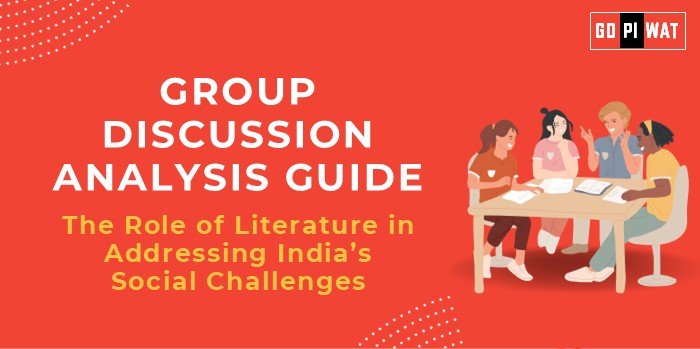📚 Group Discussion Analysis Guide
📖 The Role of Literature in Addressing India’s Social Challenges
🌟 Introduction to the Topic
Opening Context: “Literature has long been a mirror to society, reflecting its struggles, aspirations, and evolution. In India, a land of diverse voices and deep-seated social challenges, literature is both a chronicler of history and a harbinger of change.”
Topic Background: India’s literary heritage is vast, ranging from ancient epics like the Mahabharata and Ramayana to contemporary novels tackling caste, gender inequality, and economic disparities. The rise of regional and marginalized voices in Indian literature has brought critical social issues to the forefront, shaping public opinion and policy.
📊 Quick Facts and Key Statistics
- Literacy Rate in India: 77.7% (2021) – Highlights the potential reach of literature in addressing societal issues.
- Books Published Annually: 90,000+ (2023) – Reflects India’s vibrant publishing industry.
- Percentage of Regional Literature: Over 40% – Signifies the role of vernacular literature in highlighting grassroots issues.
- Global Ranking in Book Publishing: 6th largest – Demonstrates India’s literary influence globally.
🎭 Stakeholders and Their Roles
- Authors and Poets: Chroniclers and influencers addressing issues like caste, gender, and environment through creative works.
- Government Bodies: Supporting literary festivals and translating initiatives to promote regional voices.
- Publishers and Media: Facilitating the dissemination of socially relevant literature.
- Educational Institutions: Integrating impactful literary works into curricula.
- Readers and Activists: Amplifying the messages of literary works into actionable advocacy.
🏆 Achievements and Challenges
✔️ Achievements:
- Amplification of marginalized voices: Writers like Perumal Murugan and Bama highlight caste inequalities.
- Increased awareness of gender issues: Kamala Das and Ismat Chughtai’s works have spurred feminist movements.
- Global recognition: Authors like Arundhati Roy spotlight India’s issues on international platforms.
⚠️ Challenges:
- Censorship and freedom of expression: Bans on books like Salman Rushdie’s “The Satanic Verses” restrict discourse.
- Literacy divide: Accessibility to literature is limited in rural areas.
- Global comparisons: Countries like Norway heavily fund literature initiatives for societal development. India’s spending is comparatively low.
📚 Case Studies
- Kerala’s Library Movement: Boosted literacy and awareness through accessible literary resources.
- Dalit Literature in Maharashtra: Raised critical discussions on caste through local publications.
🗣️ Structured Arguments for Discussion
- Supporting Stance: “Literature acts as a societal catalyst, from addressing caste issues in Premchand’s works to modern-day environmental themes in Amitav Ghosh’s narratives.”
- Opposing Stance: “The reach of literature is limited in a country where visual media dominates and literacy rates are unequal.”
- Balanced Perspective: “While literature is impactful in initiating dialogue, its role must be complemented by activism and policy changes.”
🔍 Strategic Analysis of Strengths and Weaknesses
Strengths:
- Rich literary heritage
- Diverse voices
- International recognition
Weaknesses:
- Accessibility challenges
- Censorship concerns
Opportunities:
- Increased digital publication
- Global collaborations
Threats:
- Erosion of regional languages
- Commercialization diluting content
🎓 Connecting with B-School Applications
- Real-World Applications: Projects on the intersection of literature and policy or leveraging literature in CSR initiatives.
- Sample Interview Questions:
- “How can literature be integrated into corporate social responsibility strategies?”
- “Discuss the role of regional literature in addressing India’s caste system.”
- Insights for Students:
- Literature can inspire innovative CSR campaigns.
- Understanding cultural nuances through literature is vital for global business leaders.


